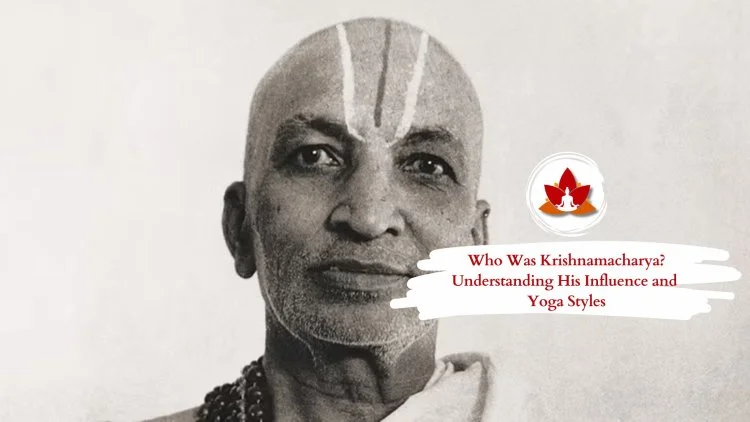Krishnamacharya: A Pioneer of Personalized Yoga Practice

Tirumalai Krishnamacharya, a name synonymous with the revival and evolution of yoga in the 20th century, was more than a yoga teacher. He was a philosopher, healer, and visionary who understood that yoga is not merely about physical flexibility or strength—it’s about creating a harmonious connection between the body, mind, and spirit. His teachings emphasized that yoga should be accessible, adaptable, and deeply personal, a message that continues to shape modern yoga practices across the world.
The Roots of a Visionary
Krishnamacharya’s early life was marked by a profound dedication to spiritual knowledge. Born in 1888 in Karnataka, India, he immersed himself in the study of Sanskrit, Ayurveda, and ancient yogic texts from a young age. His relentless pursuit of wisdom took him to the Himalayas, where he studied under Sri Ramamohan Brahmachari for over seven years. It was here that he mastered the intricacies of asana, pranayama, and meditation, along with the therapeutic applications of yoga.
This rigorous training formed the basis of his lifelong mission: to restore yoga to its rightful place as a path of holistic health and spiritual growth.
Adapting Yoga for the Individual
What truly set Krishnamacharya apart was his insistence that yoga is not a rigid set of postures but a living practice that must adapt to the needs of each practitioner. He recognized that everyone’s body, mind, and life circumstances are unique. As a result, he would often design individualized practices for his students, tailoring the asanas, breathing techniques, and meditative practices to their specific conditions.
This approach—later known as Viniyoga—laid the groundwork for yoga therapy and individualized practice as we know it today. It’s a testament to Krishnamacharya’s profound understanding of the human body and psyche. His method acknowledged that yoga’s true purpose is not about achieving impressive physical feats, but about cultivating balance, inner peace, and a deeper sense of self-awareness.
A Teacher of Teachers
Krishnamacharya’s influence extends far beyond his own students. He mentored some of the most iconic yoga teachers of the 20th century, whose contributions continue to shape the global yoga community:
-
B.K.S. Iyengar, whose precise and alignment-focused approach revolutionized how asanas are practiced.
-
K. Pattabhi Jois, who developed Ashtanga Vinyasa Yoga, a dynamic, flowing style popular worldwide.
-
Indra Devi, who brought yoga to the West, making it accessible to a global audience.
-
T.K.V. Desikachar, his son, who carried forward his father’s teachings on the therapeutic application of yoga.
Through these remarkable teachers, Krishnamacharya’s philosophy of adaptable, breath-centered practice reached millions, bridging the gap between tradition and modernity.
Embracing the Breath
One of Krishnamacharya’s most significant contributions was his emphasis on the breath. He believed that breath is the link between the body and mind, the key to unlocking the transformative power of yoga. In his teachings, every movement was synchronized with breath—a concept that became the foundation for vinyasa-based practices.
This emphasis on breath awareness not only improved physical practice but also fostered a meditative quality in movement, turning asana into a moving meditation. Today, the idea that the breath is central to yoga practice is a core principle in most modern yoga styles.
The Spiritual Dimension
For Krishnamacharya, yoga was not just a form of exercise—it was a spiritual discipline rooted in the ancient wisdom of the Yoga Sutras of Patanjali and the Bhagavad Gita. His classes often included chanting, philosophy, and meditation, reflecting his belief that yoga should nurture the whole being.
He saw yoga as a means to cultivate Dharma (righteousness), Artha (purpose), Kama (pleasure), and Moksha (liberation)—the four aims of life in Indian philosophy. In this holistic vision, yoga becomes a way of life that supports physical health, mental clarity, emotional well-being, and spiritual awakening.
A Legacy That Lives On
Krishnamacharya lived to be over 100 years old, leaving behind a legacy that continues to inspire and guide yoga practitioners worldwide. His teachings remind us that yoga is not about fitting ourselves into a pose but about using the practice to explore and honor our individual journeys.
In today’s world, where yoga is often commercialized or seen solely as a fitness regime, Krishnamacharya’s message of personalized, breath-centered, and spiritually rich practice is more relevant than ever. His life’s work calls us to slow down, listen to our inner wisdom, and honor the ancient roots of yoga.
Final Thoughts
Krishnamacharya’s teachings transcend trends and styles. They remind us that yoga is a tool for self-discovery, healing, and growth—a practice that adapts to support us through all stages of life. By honoring the individual, respecting the breath, and integrating philosophy into practice, Krishnamacharya created a timeless framework for yoga that continues to flourish.
His story is a beacon of authenticity, a testament to the enduring power of yoga when practiced with sincerity and an open heart. Today, as we roll out our mats, let us remember that we walk the path he paved, one breath at a time.
- Questions and Answers
- Opinion
- Motivational and Inspiring Story
- Technology
- Live and Let live
- Focus
- Geopolitics
- Military-Arms/Equipment
- Sicurezza
- Economy
- Beasts of Nations
- Machine Tools-The “Mother Industry”
- Art
- Causes
- Crafts
- Dance
- Drinks
- Film/Movie
- Fitness
- Food
- Giochi
- Gardening
- Health
- Home
- Literature
- Music
- Networking
- Altre informazioni
- Party
- Religion
- Shopping
- Sports
- Theater
- Health and Wellness
- News
- Culture

